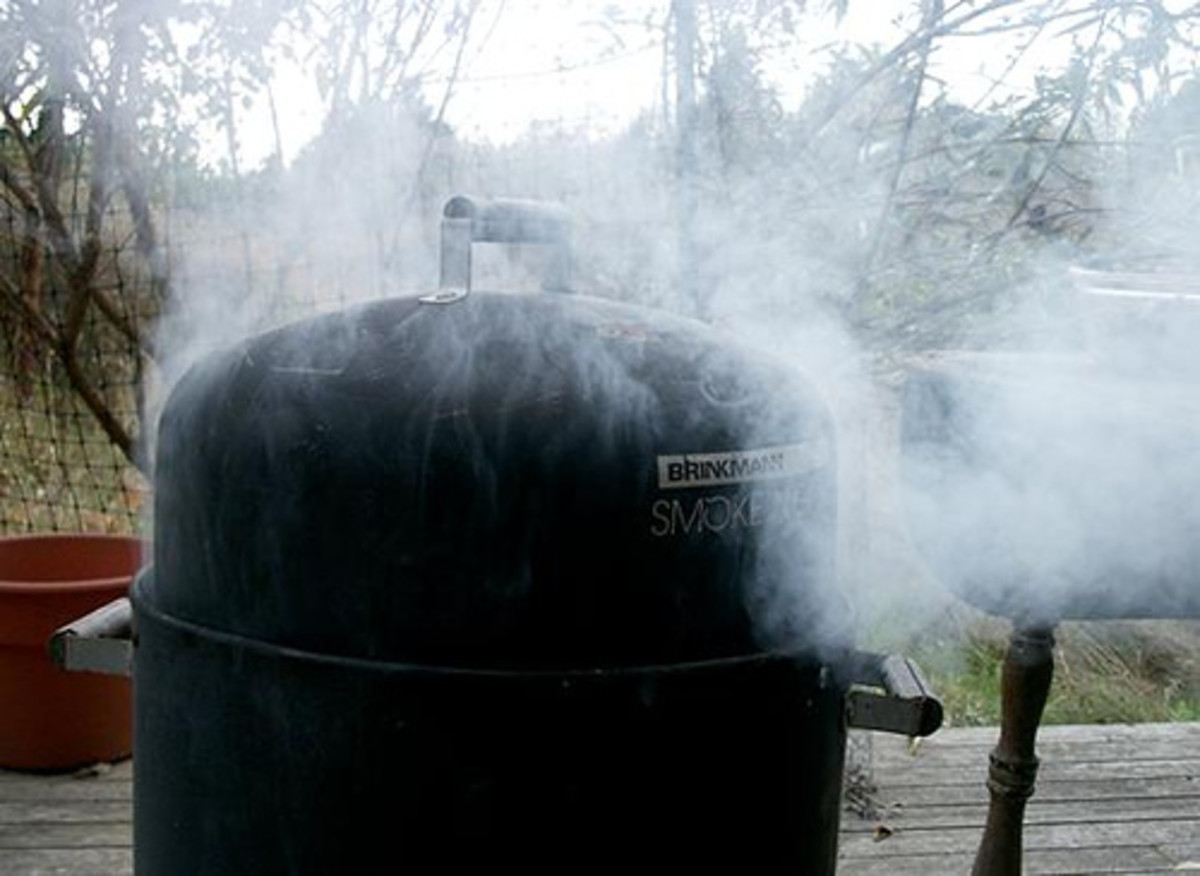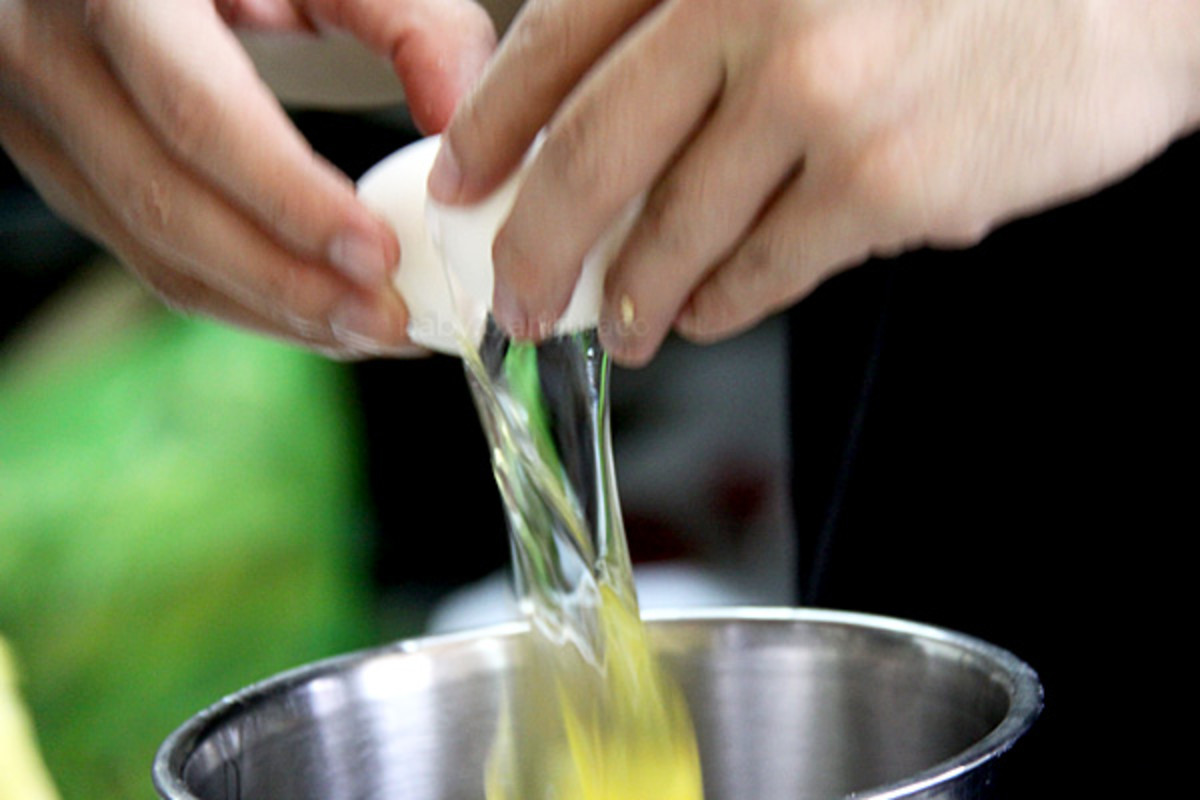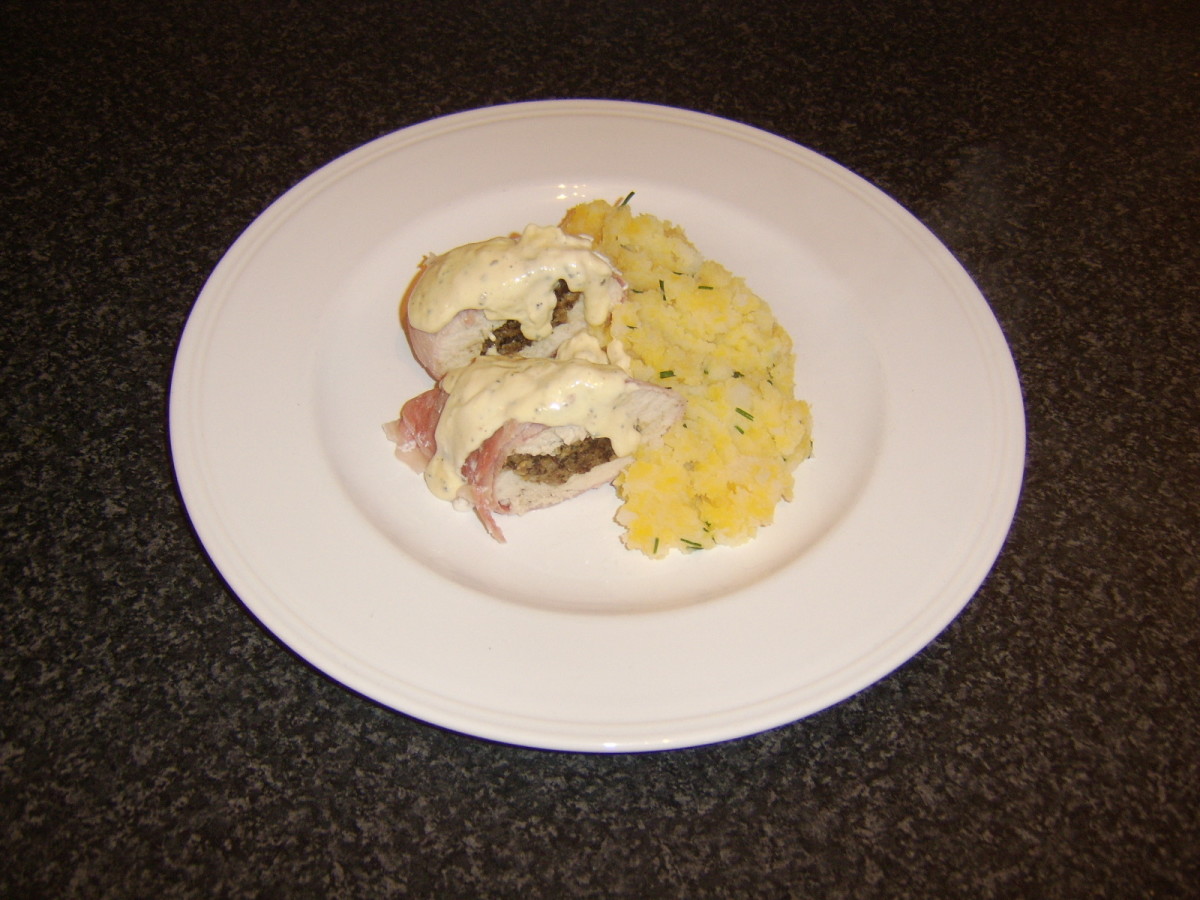Cook the Perfect Turkey!
how to cook a turkey - how to brine a turkey
Cooking the perfect turkey can be challenging. Turkey is natually low in fat, so it often dries out during cooking. Remember that classic scene from National Lampoon’s Christmas Vacation, when Chevy Chase attempts to carve the holiday turkey and the poor bird has completely dried up? Of course, this was an extreme exaggeration for comedic effect, but it’s really not a laughing matter. Just about every cook worries about her turkey being dry and tasteless. Hopefully, these Turkey cooking tips will help you serve the perfect turkey to your guests at Thanksgiving dinner.
The largest portion of a domestic turkey is the breast, which is composed of white meat. White meat is inherently dry because it has such a low fat content. Add this to the fact that turkeys have to be cooked a long time due to their size, and you have a potential culinary disaster on your hands, similar to Clark Griswold’s.
This doesn’t have to be the case, however. There are ways to ensure that your big bird is tender, juicy, and delicious!
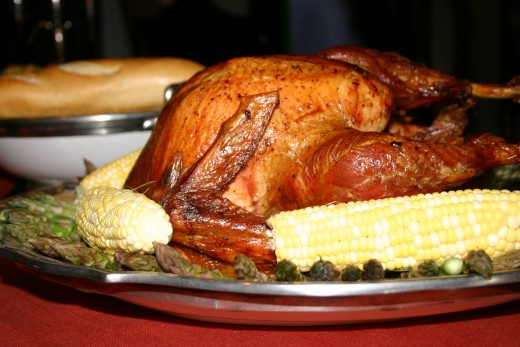
Size Does Matter!
When it comes to turkeys, size is important. Large birds are older birds, and they’re usually tougher than smaller ones. The flesh is generally not as finely grained, either. So if you need 24 pounds of turkey for your crowd, buy two 12-pound birds instead of one birdzilla. The smaller turkeys are much easier to handle, and they don’t require as much cooking time. This means there’s less chance of drying out.
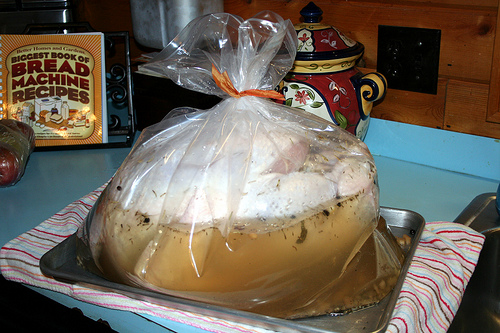
Drawing or Brining a Turkey - How to brine a turkey
Remember when you were a kid and you learned to draw a turkey by tracing your hand? Okay, you’re a grownup now, and we’re not talking about that kind of drawing. This kind of “drawing” uses salt water. In fact, I think it’s referred to as “drawing” only in the South. The rest of you call it “brining.” Okay, I admit it – that makes a lot more sense, so we'll go with that. (For fellow Southerners who might be reading, please forgive me!)
How does turkey brining work? If you recall your junior high school biology classes, you might remember a process called "osmosis." Osmosis allows molecules to pass through a semi-permeable membrane, which in this case is the skin of the turkey. When the poultry is surrounded by salt water, the water in the turkey flows out of the meat and the salt replaces it. The salt helps break down proteins in the meat. These protein molecules are too large to pass through the skin, so the cells draw in and hold more water in effort to equalize the osmotic pressure, resulting in a juicier, more tender turkey with any added flavorings you use in the turkey brine recipe.
Turkey brining has another benefit, too. Normally, cells within the turkey flesh burst at 140 degrees, which causes the meat to dry out. By changing the molecular structure of the cells, brining allows the meat to reach a temperature of 160 degrees before cellular rupturing. Again, a brined turkey means a juicier cooked bird.
How to brine a turkey? To brine a 10-14-pound turkey, you’ll need about 2 gallons of water and a cup of kosher salt for the basic brine. Adding a cup of an acidic liquid like white wine, apple juice, apple cider vinegar, or bourbon will help tenderize the meat by breaking down muscle fibers and connective tissue. Many people also like to add a cup of sweetener, like white granulated sugar, brown sugar, molasses, or honey. To this concoction, add your favorite herbs and spices, including garlic powder, black pepper, rosemary, sage, and/or ground red pepper. I’ll share a secret with you: try using a package of sausage seasoning!
Blend everything together with a whisk in a 5-gallon bucket, and add the turkey. Make sure the bird is completely submerged in the brining solution. You can also use a heavy plastic bag for this. Allow the turkey to soak for 10-12 hours.
It’s important that the turkey stays below 40 degrees, so the bucket needs to be placed in the fridge. Don’t have room in your refrigerator? Use a cooler! If the outdoor temperature is below 40 degrees, the turkey should be fine. If it’s warmer than that outside, add ice to the brine and check the solution’s temperature every few hours.
After your bird has spent enough time brining, remove it from the bucket or cooler and pat it dry. Your brined turkey is now ready for the smoker or the oven.
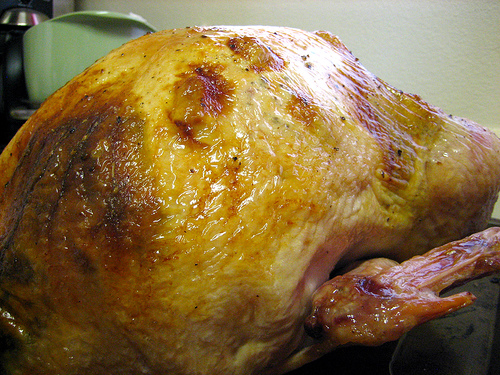
Baking or Roasting a Turkey
To cook a brined turkey in the oven, add a layer of flavorings to the bottom of a large roaster. Choose chopped carrots, apples, onions, celery, or peppers, or any combination of these. If you like, add some of your favorite fresh herbs, including rosemary, thyme, parsley, tarragon, basil, or lemon balm.
Next, tuck the wings under the bird so that they won’t overcook. Truss the legs, too. Coat the flesh with canola oil and sprinkle with salt, black pepper, red pepper, sage, and/or that sausage seasoning I told you about earlier. Place the turkey on top of the vegetables and add about a cup of water and a cup of apple juice.
Place the roaster in a preheated 375-degree oven. A 12-14-pound turkey should cook for about 3 hours and 15 minutes. About halfway through cooking, baste the bird with pan juices.
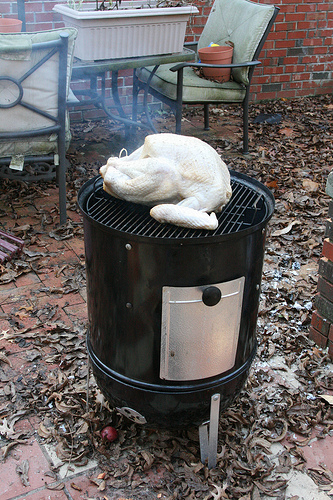
Smoked turkey
A smoked turkey has an incredible flavor, and with an electric smoker, this is a super-easy process! In the cavity of your brined bird, place a quartered apple and a quartered onion. Place the gobbler on the bottom rack of the smoker. Don’t worry about tucking the wings or trussing the legs – you’ll be cooking with moist heat, so you won’t have to worry about the meat becoming too dry.
Fill the water pan with apple juice, wine, water, or any combination of these. You can also add onions, garlic, celery, and other seasonings to the pan. On the burner element at the bottom of the smoker, place the wood you’ll be using. We like to use pecan twigs for this, but you might want to use apple, peach, hickory, oak, or mesquite. The twigs or chips should have been soaked in water overnight before use. The more wood you use, the more smoky flavor you’ll get.
This last step is very important: On the top rack, place a piece of fatty pork. A cured ham or a fresh Boston butt works well. As the pork cooks, the juices will drip onto the turkey, constantly basting it. If you choose to smoke the turkey alone, rub it with oil before cooking.
A 12-14-pound turkey will take about 10 hours to cook, but smokers with water pans are very forgiving. We actually never time ours. We put it on before we go to bed and take it off the next day about 11 a.m. About halfway through smoking, check the water pan and add more liquid, if needed.

Deep Frying
For deep-frying a turkey, you won’t need to brine it first. The turkey will be tender, juicy, and oh-so-delicious without taking any other steps. You might want to rub the cavity and the outside of the bird with your favorite seasonings or use an injector to place spices and dried herbs directly into the flesh, but you really don’t need to. Just be sure the turkey is dry and completely thawed.
Most outdoor fryers can handle 10-14-pound birds, depending on the size of the pot. Before you ever start cooking, place the turkey in the fry pot to make sure it fits. Next, fill the pot with enough water to cover the turkey. Remove the turkey and mark the water level. That way, you’ll know how much oil you’ll need.
For the best results, use peanut oil. Fill the pot to the mark you made, and heat to 360 degrees. Lower the turkey into the oil, and maintain the cooking heat at 350 degrees. Do not place the lid on the pot during frying! Cook for 3-4 minutes per pound. We cook our turkeys for about 4 minutes per pound because we like the skin to be extra crispy and crunchy.
Read more!
For some delicious recipes you might enjoy with your turkey, click the links below. I've included my heirloom recipe for Southern cornbread dressing. You'll also find an article with suggestions for what to do with leftover turkey.
- Thanksgiving Dinner: Make it Easy on Yourself!
Tips for an easy Thanksgiving dinner are provided in this article. Thanksgiving pictures are included. - Southern Culinary Arts: Old-Fashioned Southern Cornbread Dressing: Step by Step
Welcome to my online cooking school! Today's online cooking classes involve Southern cornbread and Southern cornbread dressing. This recipe is an integral part of Southern culinary arts. You don't have to... - Recipes to Make with Leftover Chicken or Turkey: Simple, Quick, and Delicious!
What to do with leftover chicken after a big Sunday dinner? Or what about all that leftover turkey from Thanksgiving and Christmas? I dont know how things are at your house, but we dont waste anything!... - Culinary Arts: Amazing No-Bake Pumpkin-Cheesecake Layered Pie
Welcome to my online cooking school! Today's culinary art is a dessert that's easy to make and delicious. I've found that some of my most popular online cooking classes involve desserts. Every Thanksgiving,... - Holle's Squash Casserole
It isnt Thanksgiving dinner at our house unless theres a yummy squash casserole on the table! Of course, we eat this dish at other times of the year, too. Sometimes I make it, and sometimes my... - Southern Cooking School: Maple Glazed Acorn Squash
Learn to cook acorn squash in my Southern cooking school! Acorn squashyou know, those pretty dark green acorn-shaped squash that you buy to use for fall decorations but rarely actually eat. If... - A Low Carb Thanksgiving Feast
Low carbing it? If so, you might already be dreading Thanksgiving, what with all the pies, cakes, mashed potatoes, and stuffing. With a little ingenuity, however, you can enjoy a delicious feast and still not...


